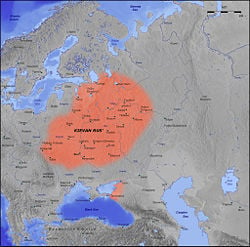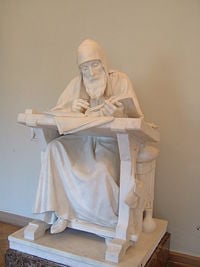Difference between revisions of "Tale of Bygone Years" - New World Encyclopedia
m (Robot: Remove contracted tag) |
m (Robot: Remove submitted tag) |
||
| Line 1: | Line 1: | ||
| − | {{Images OK | + | {{Images OK}} |
The '''''Primary Chronicle''''' (Old-Slavonic: Пов{{Unicode|ѣ}}сть времяньныхъ л{{Unicode|ѣ}}тъ; [[Russian language|Russian]]: Повесть временных лет, ''Povest' vremennykh let''; [[Ukrainian language|Ukrainian]]: Повість времмених літ, ''Povist' vremennykh lit''; often translated into English as '''''Tale of Bygone Years'''''), is a history of the [[Kievan Rus']] from around 850 to 1110 originally compiled in [[Kiev]] about 1113.<ref>MSN Encarta, ''Russian Literature'', [http://encarta.msn.com/encyclopedia_761564269/Russian_Literature.html The Kyiv Period] Retrieved December 20, 2007.</ref> There are three editions of the work. The first was mainly composed of humorous and biographical stories and is thought to have been composed by the monk [[Nestor the Chronicler|Nestor]]. The second edition was an edited version of the first completed by [[Sylvestr of Kiev|Sylvester]], while the third was compiled by an unknown author who helped to update information regarding the ancient city of Byzantine. Two manuscripts, the [[Laurentian codex]] and the [[Hypatian codex]] exist. The five main witnesses to the original who composed subsequent version were: Laurentian (RNB, F.IV.2 composed in 1377), Radziwill (BAN, 34. 5. 30 circa the 1490s), Academy (RGB, MDA 5/182 dated to the 15th century), Hypatian (BAN, 16. 4. 4 circa 1425), and Khlebnikov (RNB, F.IV.230 dated to 16th century). The Khlebnikov version contains numerous gaps which are supplemented by Pogodin (RNB, Pogodin 1401 composed in the early 17th century).<ref>Answers.com, ''Primary Chronicle'', [http://www.answers.com/topic/primary-chronicle from the Russian History Encyclopedia] Retrieved December 20, 2007.</ref> | The '''''Primary Chronicle''''' (Old-Slavonic: Пов{{Unicode|ѣ}}сть времяньныхъ л{{Unicode|ѣ}}тъ; [[Russian language|Russian]]: Повесть временных лет, ''Povest' vremennykh let''; [[Ukrainian language|Ukrainian]]: Повість времмених літ, ''Povist' vremennykh lit''; often translated into English as '''''Tale of Bygone Years'''''), is a history of the [[Kievan Rus']] from around 850 to 1110 originally compiled in [[Kiev]] about 1113.<ref>MSN Encarta, ''Russian Literature'', [http://encarta.msn.com/encyclopedia_761564269/Russian_Literature.html The Kyiv Period] Retrieved December 20, 2007.</ref> There are three editions of the work. The first was mainly composed of humorous and biographical stories and is thought to have been composed by the monk [[Nestor the Chronicler|Nestor]]. The second edition was an edited version of the first completed by [[Sylvestr of Kiev|Sylvester]], while the third was compiled by an unknown author who helped to update information regarding the ancient city of Byzantine. Two manuscripts, the [[Laurentian codex]] and the [[Hypatian codex]] exist. The five main witnesses to the original who composed subsequent version were: Laurentian (RNB, F.IV.2 composed in 1377), Radziwill (BAN, 34. 5. 30 circa the 1490s), Academy (RGB, MDA 5/182 dated to the 15th century), Hypatian (BAN, 16. 4. 4 circa 1425), and Khlebnikov (RNB, F.IV.230 dated to 16th century). The Khlebnikov version contains numerous gaps which are supplemented by Pogodin (RNB, Pogodin 1401 composed in the early 17th century).<ref>Answers.com, ''Primary Chronicle'', [http://www.answers.com/topic/primary-chronicle from the Russian History Encyclopedia] Retrieved December 20, 2007.</ref> | ||
[[Image:Kievan_Rus_en.jpg|thumb|250px|Map of the Kievan Rus', Eleventh century]] | [[Image:Kievan_Rus_en.jpg|thumb|250px|Map of the Kievan Rus', Eleventh century]] | ||
Revision as of 00:29, 12 April 2008
The Primary Chronicle (Old-Slavonic: Повѣсть времяньныхъ лѣтъ; Russian: Повесть временных лет, Povest' vremennykh let; Ukrainian: Повість времмених літ, Povist' vremennykh lit; often translated into English as Tale of Bygone Years), is a history of the Kievan Rus' from around 850 to 1110 originally compiled in Kiev about 1113.[1] There are three editions of the work. The first was mainly composed of humorous and biographical stories and is thought to have been composed by the monk Nestor. The second edition was an edited version of the first completed by Sylvester, while the third was compiled by an unknown author who helped to update information regarding the ancient city of Byzantine. Two manuscripts, the Laurentian codex and the Hypatian codex exist. The five main witnesses to the original who composed subsequent version were: Laurentian (RNB, F.IV.2 composed in 1377), Radziwill (BAN, 34. 5. 30 circa the 1490s), Academy (RGB, MDA 5/182 dated to the 15th century), Hypatian (BAN, 16. 4. 4 circa 1425), and Khlebnikov (RNB, F.IV.230 dated to 16th century). The Khlebnikov version contains numerous gaps which are supplemented by Pogodin (RNB, Pogodin 1401 composed in the early 17th century).[2]
Three editions
For a long time the original compilation was attributed to a monk named Nestor, and hence it was formerly referred to as Nestor's Chronicle, or Nestor's manuscript. Among many sources he used were earlier (now lost) Slavonic chronicles, Byzantine annals of John Malalas and George Hamartolus, native legends and Norse sagas, several Greek religious texts, Rus-Byzantine treaties, oral accounts of Yan Vyshatich and other military leaders. Nestor worked at the court of Sviatopolk II of Kiev and probably shared his pro-Scandinavian policies.
The early part is rich in anecdotal stories, among which are the arrival of the three Varangian brothers, the founding of Kiev, the murder of Askold and Dir, the death of Oleg, who was killed by a serpent concealed in the skeleton of his horse, and the vengeance taken by Olga, the wife of Igor, on the Drevlians, who had murdered her husband. The account of the labors of Saints Cyril and Methodius among the Slavic peoples is also very interesting, and to Nestor we owe the tale of the summary way in which Vladimir the Great suppressed the worship of Perun and other idols at Kiev.
In the year 1116, Nestor's text was extensively edited by hegumen Sylvester who appended his name at the end of the chronicle. As Vladimir Monomakh was the patron of the village of Vydubychi where his monastery is situated, the new edition glorified that prince and made him the central figure of later narrative. This second version of Nestor's work is preserved in the Laurentian codex.
A third edition followed two years later and centered on the person of Vladimir's son and heir, Mstislav the Great. The author of this revision could have been Greek, for he corrected and updated much data on Byzantine affairs. This latest revision of Nestor's work is preserved in the Hypatian codex.
Two manuscripts
Because the original of the chronicle as well as the earliest known copies (the Laurentian codex and the Hypatian codex) are lost, it is difficult to establish the original content of the chronicle, word by word.
The Laurentian codex was copied by the Nizhegorod monk Laurentius for the Prince Dmitry Konstantinovich in 1377. The original text he used was a lost codex compiled for the Grand Duke Mikhail of Tver in 1305. The account continues until 1305, but the years 898-922, 1263-83 and 1288-94 are missing for unknown reason. The manuscript was acquired by the famous Count Musin-Pushkin in 1792 and subsequently presented to the Russian National Library in St Petersburg.
The Hypatian codex was discovered at the Ipatiev Monastery of Kostroma by the Russian historian Nikolay Karamzin. The Hypatian manuscript dates by 15th century, but it incorporates much information from the lost 12th-century Kievan and 13th-century Halychian chronicles. The language of this work is East Slavic version of Church Slavonic language with many additional irregular east-slavisms (like other east-slavic codexes of the time).
Numerous monographs and published versions of the chronicle have been made, the earliest known being in 1767. Aleksey Shakhmatov published a pioneering textological analysis of the narrative in 1908. Dmitry Likhachev and other Soviet scholars partly revisited his findings. Their versions attempted to reconstruct the pre-Nestorian chronicle, compiled at the court of Yaroslav the Wise in the mid-11th century.
Assessment
Unlike many other medieval chronicles written by European monks, the Tale of Bygone Years is unique as the only written testimony on the earliest history of East Slavic peoples. Its comprehensive account of the history of Kievan Rus is unmatched in other sources, although important correctives are provided by the Novgorod First Chronicle. It is also valuable as a prime example of the Old East Slavonic literature. No original copies remain; only secondary versions of the work are available to study. The piece has generated an extensive amount of historical research.
Notes
- ↑ MSN Encarta, Russian Literature, The Kyiv Period Retrieved December 20, 2007.
- ↑ Answers.com, Primary Chronicle, from the Russian History Encyclopedia Retrieved December 20, 2007.
ReferencesISBN links support NWE through referral fees
- Primary Chronicle Answers.com. Retrieved December 20, 2007.
- Cross, Samuel Hazzard, and Olgerd P. Sherbowitz-Wetzor. The Russian Primary Chronicle. Cambridge, MA: Mediaeval Academy, 1953. OCLC: 268919. This is an English translation and commentary.
- Milner-Gulland, Robin. The Russians. Malden, MA: Blackwell Publishing, 1997. ISBN 0631218491
- Ostrowski, Donald, David J. Birnbaum, and Horce G. Lunt, eds. The Povest' vremennykh let: An Interlinear Collation and Paradosis. Cambridge, MA: Harvard Ukrainian Research Institute, 2004. ISBN 0916458911
- Online from Harvard Retrieved December 12, 2007. A collation of the chronicle in Cyrillic is available with an erudite and lengthy introduction in English. This is an interlinear collation including the five main manuscript witnesses, as well as a new paradosis, or reconstruction of the original.
External links
- The main codices (Laurentian, Hypatian, Novgorodian) in Cyrillic Retrieved December 12, 2007.
- Excerpts of primary chronicle, including founding of Novgorod by Rus, Attacks on Byzantines, and Conversion of Vladimir Also mentions several slavic tribes by name. Retrieved December 12, 2007.
Credits
New World Encyclopedia writers and editors rewrote and completed the Wikipedia article in accordance with New World Encyclopedia standards. This article abides by terms of the Creative Commons CC-by-sa 3.0 License (CC-by-sa), which may be used and disseminated with proper attribution. Credit is due under the terms of this license that can reference both the New World Encyclopedia contributors and the selfless volunteer contributors of the Wikimedia Foundation. To cite this article click here for a list of acceptable citing formats.The history of earlier contributions by wikipedians is accessible to researchers here:
The history of this article since it was imported to New World Encyclopedia:
Note: Some restrictions may apply to use of individual images which are separately licensed.

